(How to deadlift? (legs exercises
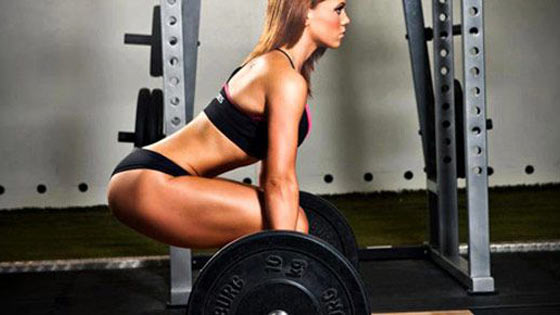
This basic strength exercise develops the entire body and allows you to gain a lot of strength. Nothing beats the deadlift – or “Deadlift” in English – to gain mass, except perhaps the squat . It works the quadriceps, the back of the thighs, the glutes, the back, calves, abs, lumbar, trapezius and even the forearms.
For some, it is essential if you want to build a strong and massive physique. For others, it is too risky and replaceable by other exercises. The deadlift unleashes passions, and everyone has an opinion on the issue.
The deadlift: a useful movement!
The deadlift is certainly one of the best bodybuilding exercises, but also one of the most ignored. The reasons are multiple:
 This is a difficult exercise to perform well. It requires strict learning and a gradual increase in load before mastering it. This requires humility and patience, qualities not always present, especially among young people.
This is a difficult exercise to perform well. It requires strict learning and a gradual increase in load before mastering it. This requires humility and patience, qualities not always present, especially among young people.
 It's a grueling exercise. A series of deadlifts, brought almost to the limit, while maintaining good form, requires a lot of energy. This is one of the points it has in common with the squat. The exercises that follow may even suffer a little. Conversely, it is because it is so hard that the deadlift can bring so many results.
It's a grueling exercise. A series of deadlifts, brought almost to the limit, while maintaining good form, requires a lot of energy. This is one of the points it has in common with the squat. The exercises that follow may even suffer a little. Conversely, it is because it is so hard that the deadlift can bring so many results.
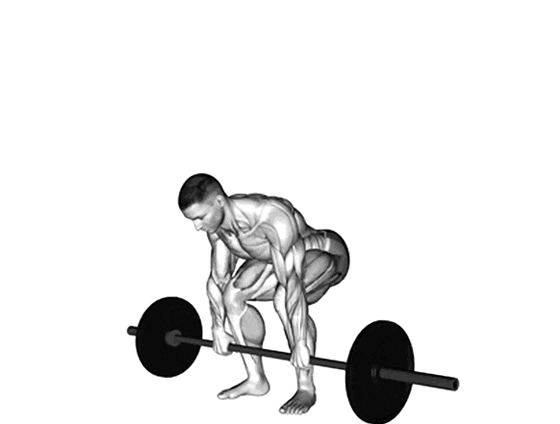
 It requires little investment in equipment. A bar and weights are enough for its practice. It is clear that in modern fitness rooms, this little equipment does the job. The machines attract more customers than a simple bar loaded with discs. However, from the point of view of efficiency, there is no comparison. The deadlift shares with dips this characteristic of a movement requiring little investment in equipment, but nevertheless providing great muscular efficiency.
It requires little investment in equipment. A bar and weights are enough for its practice. It is clear that in modern fitness rooms, this little equipment does the job. The machines attract more customers than a simple bar loaded with discs. However, from the point of view of efficiency, there is no comparison. The deadlift shares with dips this characteristic of a movement requiring little investment in equipment, but nevertheless providing great muscular efficiency.
GOOD FOR MUSCLE GAIN AND POSTURE
Beach bodybuilders are only interested in pecs and biceps (men), or abs and glutes (women). And since they represent the majority of gym subscribers, we are not surprised by the lack of interest in an exercise that can really contribute to achieving a beautiful physique. However, the deadlift is undoubtedly the one that competes with the squat for the prize of the most effective exercise from a muscular and postural point of view.
It is undoubtedly the exercise that involves the most muscles for its execution, from the heels to the back of the neck, including the forearms, the deadlift works the entire rear muscular chain, plus a few other muscles , which makes it a perfect exercise to get really strong, and therefore progress in all the other movements. In this way, it uses even more muscles than the squat (forearms, trapezius or back muscles, not used in the squat). From this point of view, the deadlift can be classified equally into movements for the upper body or the lower body, since it works both!
Its mastery allows, among other things, the strengthening of the back muscles, the lumbar in particular, a chronic weak point of our contemporaries, and a source of colossal costs for social security and health insurance.
Learning good posture in practice allows the acquisition of commonly reusable skills. We could also qualify the deadlift as a “natural” movement, that is to say with high reuse in everyday life, compared to “artificial” movements, strengthening a certain number of muscles, but without real reuse in everyday life. Can anyone tell me what lateral elevations or abductor work are used for in everyday life, or even for gaining muscle mass? However, they are among the most often used exercises.
What muscles does the deadlift work?
This movement is very complete. More than 200 major muscles participate. Aside from the Olympic lifts, no other movement uses so many muscles at once.
 The work will be different depending on the person and will depend on their body shape. A person with long limbs will tilt their back more and put more strain on the glutes and lower back. A person with short limbs will be able to place their glutes lower and straighten their back with a position close to a squat, which will put more strain on the quadriceps.
The work will be different depending on the person and will depend on their body shape. A person with long limbs will tilt their back more and put more strain on the glutes and lower back. A person with short limbs will be able to place their glutes lower and straighten their back with a position close to a squat, which will put more strain on the quadriceps.
- The lower back is stressed statically. It is often said that the deadlift is a movement for the lower back, this is incorrect because these muscles, which are very used, are posture-maintaining muscles but do not participate in the kinematics of the movement. On the contrary, it is important that the spine remains straight !
- The abdominals, opposite the lower back, also play a major role in maintaining a straight trunk. A good abdominal contraction is necessary before starting the movement and will be maintained throughout the movement.
- The quadriceps help lift the load at the start of the movement. The greater or lesser use of the quadriceps also depends on each person's morphology.
- The hamstrings (back of the thighs) participate, with the glutes, in straightening the body. These muscles are certainly the most used in the dynamics of the movement. For those who want to have a beautiful, plump butt, the deadlift is certainly a must!
- The back muscles actively participate in maintaining and stabilizing the bar. The deadlift therefore also contributes to obtaining that pretty V-shaped back that you dream of! Skeptics can try a set of pull-ups before and after a deadlift session. They will understand better.
- The forearms are very stressed, statically like the lower back. These are often the muscles that limit progression in the deadlift! As such, the deadlift could be considered a forearm specialization movement. Mixed with a few pull-ups and curls, Popeye's forearms are yours!
- The trapezius also helps hold the bar, especially at the end of the movement. It's common to have some good soreness in these muscles after a good deadlift session.
- The arms, especially the biceps, also help hold the bar. Don't plan on lifting 200 kg with 30 cm arms!
- The calves serve as leg stabilizers throughout the movement. It even seems that many powerlifters have good calves without ever working them specifically, just with the squat and deadlift.
In short, the deadlift uses almost every muscle in the body! Apart from the pectorals, as well as the triceps and shoulders (and more), you will not have a muscle left dry after your session. So, a dip session after your deadlift will perfectly complement your workout, and there will be no need for anything extra!
How to deadlift?
You must first adjust the height of the bar, to mid-calf or higher. Grip the bar with your hands shoulder-width apart. The feet are sufficiently apart and pointed outwards. Position yourself, keep the natural arch of your lower back and contract your abdominals. Then raise the bar to knee level using the quadriceps, then straighten your torso.
If you are new to the movement, it is advisable to work at a reduced amplitude and take mini breaks between repetitions to get back into position.
This exercise can be harmful if poorly performed, and tiring if you use very heavy weights. Beginners in bodybuilding must learn it in the gym with a state-certified professional.
Tutorial: More powerful deadlift!
A pushed deadlift - or a load too weak for Julien ;)
Learning good posture in practice is essential before increasing weight. You can carry very heavy loads in the deadlift, much greater than your own body weight. Before getting there, it is essential to master the technique in order to do it with maximum safety.

The key to the deadlift is to balance the effort between pushing the legs and straightening the core.
 It is obligatory to do it flat with flat shoes. Heeled shoes should be avoided, as should going barefoot. We cannot afford to make mistakes with weights at 150 or 200% of body weight.
It is obligatory to do it flat with flat shoes. Heeled shoes should be avoided, as should going barefoot. We cannot afford to make mistakes with weights at 150 or 200% of body weight.
 Lay a rubber mat under the weights. It may happen that the dumbbell hits the floor a little too quickly, although normally the movement should be quite slow. In the event of sudden contact, the floor may suffer. Particularly if you practice in your apartment, think about both the floor/tiles and the neighbors! This brutal contact can also have impacts on your joints following the vibrations generated.
Lay a rubber mat under the weights. It may happen that the dumbbell hits the floor a little too quickly, although normally the movement should be quite slow. In the event of sudden contact, the floor may suffer. Particularly if you practice in your apartment, think about both the floor/tiles and the neighbors! This brutal contact can also have impacts on your joints following the vibrations generated.
 It is imperative to keep your back straight throughout the movement (2). The end of the movement must be done with the body vertical, neither forward nor backward. A body too far back at the end of the movement can cause pinching of the intervertebral discs. A back bent forward at the end of the movement is not good either. Don't be afraid to raise the bar a little, especially at the beginning. When you can increase the load by putting 20 kg discs, the bar will then be at the right height because these discs already have a good diameter.
It is imperative to keep your back straight throughout the movement (2). The end of the movement must be done with the body vertical, neither forward nor backward. A body too far back at the end of the movement can cause pinching of the intervertebral discs. A back bent forward at the end of the movement is not good either. Don't be afraid to raise the bar a little, especially at the beginning. When you can increase the load by putting 20 kg discs, the bar will then be at the right height because these discs already have a good diameter.
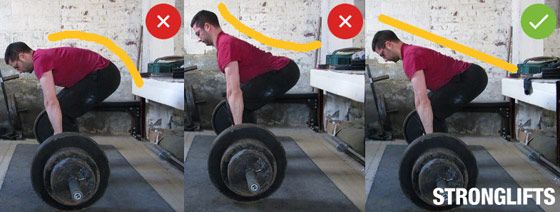
Left: round back. Middle: excessive arching. Right: neutral position.
 Keep the bar as close to the body as possible (1). If the bar bothers you because it rubs on your shins, don't hesitate to wear a shin guard or high socks. Do not lean too far forward or you risk unbalancing yourself.
Keep the bar as close to the body as possible (1). If the bar bothers you because it rubs on your shins, don't hesitate to wear a shin guard or high socks. Do not lean too far forward or you risk unbalancing yourself.
 Do not jerk when starting the movement; the bar should take off slowly. This helps both avoid a sudden shock to the lower back and unbalance you.
Do not jerk when starting the movement; the bar should take off slowly. This helps both avoid a sudden shock to the lower back and unbalance you.
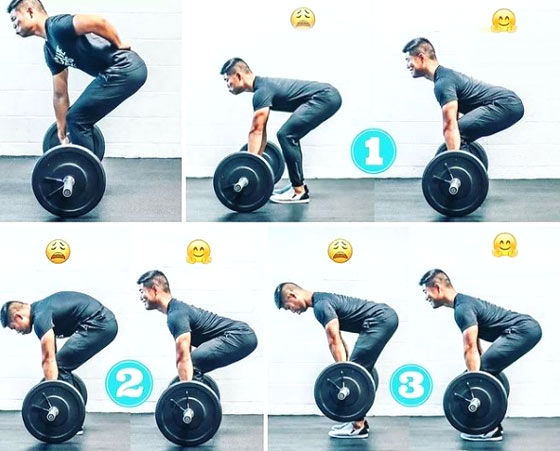
 Look into the distance, like in a squat. This is a great way to keep your back straight.
Look into the distance, like in a squat. This is a great way to keep your back straight.
 Raise your hips and shoulders at the same time (3). Perfect synchronization of the two allows for the best movement. Avoid, for example, raising the hips first and then straightening the load using lumbar strength alone, as we sometimes see people do. This movement is a variation of the deadlift, requiring excellent flexibility and not allowing you to take loads as heavy as the basic movement.
Raise your hips and shoulders at the same time (3). Perfect synchronization of the two allows for the best movement. Avoid, for example, raising the hips first and then straightening the load using lumbar strength alone, as we sometimes see people do. This movement is a variation of the deadlift, requiring excellent flexibility and not allowing you to take loads as heavy as the basic movement.
 After a deadlift session, back stretches help put the vertebrae, compressed by the load, back into place (the same goes for the squat, by the way).
After a deadlift session, back stretches help put the vertebrae, compressed by the load, back into place (the same goes for the squat, by the way).
Breathing
Inhale before ascent, but do not hold your breathing, this could cause a temporary surge which could lead to dizziness. So blow very hard throughout the entire rise of the load. In the high position, resume your breathing and repeat the maneuver to place the bar on the ground. A repetition therefore includes two breaths.
Compress your stomach and back muscles. This maneuver helps keep the back straight, by sheathing the spine with a chain of hard muscles. It is anyway impossible to achieve a good movement on a heavy load otherwise. In this context, the deadlift also offers a good abs session.
It is advisable not to block your breathing during exercise. However, this maneuver helps minimize the risk of injury when the load is really heavy. Blocked breathing and contracted abdominals support the trunk and protect the spine during the critical part of the movement, as long as you keep your back straight. So inhale at the bottom position, hold the breath, lift the bar and then exhale. To lower the bar, inhale and tighten your abs.
Safety instructions
It is better to learn this bodybuilding exercise in the gym with a state-certified professional and to be interested in the biomechanics of the movement. Film yourself to analyze how you perform the exercise. It is true that this exercise is risky. But it allows you to learn how to lift loads correctly from the ground, which is very useful for other exercises but also in our daily lives when you have to pick up a heavy object or lift a piece of furniture.
At the slightest contracture, pain or discomfort, try to understand what is wrong. If you don't listen to your body and ignore the warnings it sends you, it always ends in injury.
The deadlift like the squat, even if done well, remains tiring for the vertebrae and joints if you use very heavy weights. Not everyone has the build to endure this for years.
Is the deadlift really dangerous?
Humility and patience are necessary when learning to deadlift. This exercise is potentially dangerous for the back if performed incorrectly. This danger is often at the origin of arguments against the practice of deadlifting. For me, it is an advantage that this exercise is visibly potentially dangerous: how many hidden risky movements are there in bodybuilding? A lot. Unfortunately we only notice it when it is too late.
It must be said once and for all: all exercises are potentially dangerous when done incorrectly. In particular, machines leave a false sense of security, but how many of them are truly well designed? How many users take the time to adjust the settings to their body type? In bodybuilding as in other areas, safety is also active. And learning the perfect deadlift movement is one of the disciplines to acquire if you want to achieve good results in complete safety.
In everyday life, mastering the deadlift and associated postures (straight back, bent legs) allows you to move heavy objects without difficulty. Who has never had to move a box of bottles, books, bags of cement, lift flower pots, move a cupboard, lift a loaded wheelbarrow or simply carry a box of errands? The deadlift builds the muscles of the back and legs allowing these daily actions. Better: he learns the posture to take to exercise them without risk of injury.
In summary, practice the deadlift and its derivatives without moderation. If bodybuilders spent half their biceps exercises on deadlifts, there would be tons more muscle in the gym over the next few months and a lot fewer back problems.
Deadlift variations
As with many exercises, there are many variations of the deadlift. It's up to you to choose your favorite based on your objective, your strengths and weaknesses.
THE SPLIT-LEG DEADLIFT
By playing on the position of the feet and the spacing of the thighs, you use different muscle groups to a greater or lesser extent. For example, if the thighs are very apart and the feet placed in a duck position - like in the Sumo deadlift - it is the inside of the thighs that will be targeted, at the level of the adductors. In this case, the arms should be placed between the thighs. This variation, called “sumo”, works more on the thighs and less on the back. It can therefore be chosen by those fearing for their back with the basic movement. It also requires a certain flexibility to be able to keep the bar against the legs. Depending on the morphology, the load can be heavier or lighter compared to the basic movement. This is also a possible variation if you want to work the deadlift several times during the week.
THE STRETCH-LEGED DEADLIFT
The straight leg deadlift highlights the lumbar muscles, hamstrings and glutes. The quadriceps no longer work. It requires a certain flexibility for its successful implementation. People who don't have enough of it should instead practice the partial form of the movement. This is often the movement taken in addition to the squat to work the legs completely. The trio squat + straight leg deadlift + calf raises is the one that will char your legs!
THE ROMANIAN LIFT
The Romanian deadlift is recommended for people who do not have the flexibility to perform the deadlift with straight legs. It allows you to keep your back flat up to your physiological limit, and I strongly recommend it compared to the straight leg variation.
To perform this movement correctly, it is more practical to start from a bar rest. Keep your legs slightly bent to secure your back. We can also limit the descent of the bar to knee level for people who really lack flexibility.
The loads are lower than the classic deadlift, or even the squat. In addition, since the bar is not rested, the forearms can quickly limit the movement. It nevertheless remains an excellent exercise for working the hamstrings, much superior to the traditional leg curl, and possibly less demanding on the knee joints (especially on poorly designed machines).
THE HEXAGONAL BAR LIFT
The hex bar deadlift is a less stressful exercise for the lower back because it allows the torso to have a more upright position. It also allows you to lift a little heavier. Unfortunately, not all gyms have this type of bar.
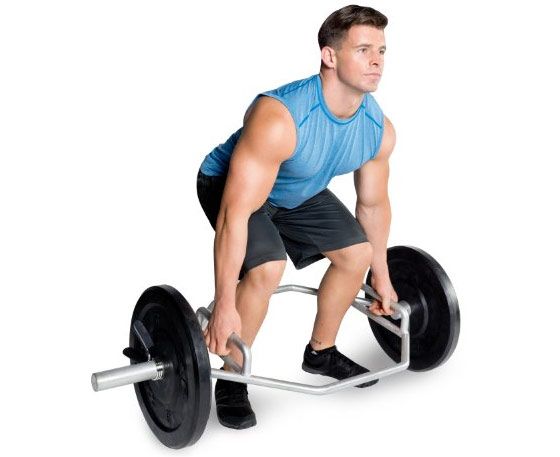
Deadlift FAQ
IN THE STARTING POSITION, I DON'T LET MY THIGHS ENOUGH IN THE DEADLIFT, AND I'M LEANING TOO FORWARD. IS MY TECHNIQUE BAD?
Yes, indeed, that is the case. But that doesn't mean your technique is bad; she's just different. Some push with their thighs, and others pull with their back because their thighs are long and less strong. They therefore tend to start the movement with their hips high, with their torso leaning. Those who have short, strong thighs and a long bust - a different body shape from yours - can start with low hips, keeping the bust straighter.
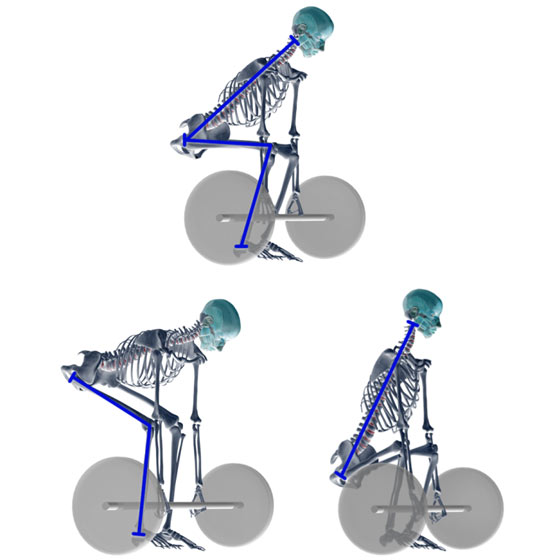
Long legs + short torso VS Long torso + short legs
WHICH BAR GRIP TO USE FOR DEADLIFT?
The grip of the bar can be pronated (palms facing the ground), supinated or mixed. I strongly suggest keeping the grip pronated as much as possible. Supinated grip proves impractical.
The mixed grip, advocated by many people, is valid for powerlifters taking very heavy loads (up to 4 times their weight), or for short series. It allows a better hold on the bar, preventing it from rolling. This grip is unbalanced, and risks causing injury if you are not careful. In particular, starting too quickly causes the bar to rotate in the horizontal plane.
It is preferable to ensure a good grip on the bar using strong forearm muscles. This power is worked with, among other things, deadlifts and pull-ups. A good idea is to alternate the grip between each set.
In the traditional movement, the hands are outside the knees, about natural shoulder width.
IS THE BELT USEFUL FOR DEADLIFT?
The weight belt or lumbar belt is only justified for very heavy loads. It does not guarantee that you will not have problems with your back. The mistake would undoubtedly be to believe that with the belt we no longer have to contract the abs and back muscles to lift the load, when it is quite the opposite. Start there, with a deep but not maximal inspiration, before starting the movement. When the trunk is rigid, then start lifting. The bar starts slowly, to avoid a jolt in the lower back, and the breath is never blocked: a whistling sound between tight lifts slowly empties the lungs, without raising blood pressure too much (the one which can leave a black veil afterwards). movement).
HOW FREQUENCY TO TRAIN FOR THE DEADLIFT?
When you start the movement, with light loads, it is entirely possible to practice it twice a week. Then, you have to be more vigilant, because the lumbar muscles take quite a while to recover. In this case, especially if you also work the squat, it is wise to only work the deadlift once a week. Respecting this deadline is as important physically as psychologically: going to a deadlift session backwards is out of the question. This movement is approached with the morale of a winner!
HOW MANY REPS FOR THE DEADLIFT?
At the beginning, with still low loads, you can practice deadlifting in long series. Despite this, the weights rise very quickly, and we quickly manage to exceed our body weight. At this point, you should seriously consider reducing the number of repetitions per set. So to start, there's no need to take it heavy: 3 sets of 20 repetitions with the empty bar as the only load can already give serious aches to people starting out with this movement. In this case, make sure to place the bar at a sufficient height from the ground so as not to have to bend your back.
Rest the bar between 2 repetitions. In this way, you will be able to repeat the movement with the best possible position to maintain perfect movement. This precaution is imperative on short series (<5 repetitions) which do not suffer from any technical imperfection, given the weight lifted.
During long series of deadlifts (>12 repetitions), do not hesitate to pause the bar on the ground to catch your breath between 2 repetitions. This is often the only condition for hoping to complete the series until the end. So, a set of 20 deadlift repetitions can take 3 or 4 minutes! The deadlift accommodates these mini breaks between repetitions very well.
It is not advisable to go to muscular failure in the deadlift, at least not before having acquired excellent technical mastery of the movement. Indeed, an inexperienced person will tend to use poor form at the end of the exercise, thereby increasing the risk of injury.
IS THERE AN ALTERNATIVE TO THE DEADLIFT?
Faced with the qualities of this movement in classic bodybuilding, some who are always afraid are always looking for a hypothetical alternative to this movement. Unfortunately it does not exist. The only movements that develop so many muscular qualities are the derivatives of the Olympic movements: Power Clean and Power Snatch. Indeed, these movements work the same muscle chains, but I don't see how you can perform these movements without already having concrete deadlift experience.
The deadlift will therefore never be completely replaced by the accumulation of small movements which, in addition to being incomplete, will not make the body work as a complete chain. In short, don't be afraid of movement. It doesn't necessarily look great, requires little equipment, but certainly remains the most effective movement in the entire bodybuilding arsenal.
HOW TO PLACE THE DEADLIFT SO AS TO NOT OVERLOAD THE LUMBAR?
The deadlift uses, among other things, the lumbar muscles. These are also used in other movements such as the squat and the barbell row. Be careful not to overload them during the same session and therefore avoid mixing deadlifts and squats in this one. If you want to combine them during the same workout, then consider the sum of the repetitions of the two movements as a solicitation of the lumbar muscles.
Vertical presses also stress the lower back, especially when done standing. Again, be careful not to put too much strain on your vertebrae by avoiding positioning the deadlift as much as possible in an intense shoulder session that includes lifting weights overhead.
“Olympic” movements also stress the lower back. Also avoid mixing them with deadlifts in the same workout. By following these easy-to-implement tips, you reduce the risk of injury.
WHAT PROGRAM TO DO TO PROGRESS IN DEADLIFT?
Here is a basic program based on 2 alternating full-body workouts. Take a day off between sessions: session 1, rest, session 2, rest, etc.
PROGRAM 1
- Bench press: 4 x 10
- Rowing: 4 x 10
- Military press: 3 x 8
- Squat: 4 x 10
- Romanian deadlift: 3 x 12
- Calf raises: 3 x 15
- Shrugs: 3 x 15
PROGRAM 2
- Deadlift: 4 x 8
- Squat 1 leg: 4 x 10
- Pull-ups: 5 x 6
- Dips: 5 x 8
- Curls bar: 3 x 8
- Crunches: 3 x 20
Note the presence of two variations of the deadlift. In principle, this way it works. If that's too much, cut out the Romanian deadlifts, but that's a shame. The heart of the program is session 2 of deadlift
Light version, for Hardgainers:
- Program 1: Bench press: 4 x 10, Rowing: 4 x 10, Squat: 4 x 10, Calf raises: 3 x 15
- Program 2: Deadlift: 3 x 8, Pull-ups 3 x 6, Dips 3 x 8, Crunches: 3 x 20
.png)